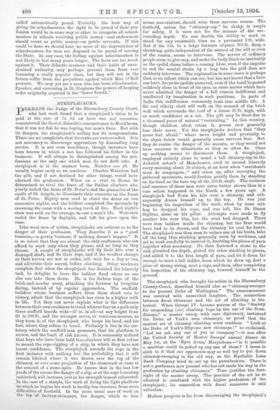STEEPLEJACKS.
PERHAPS the Judge of the Bloomsbury County Court, who last week found that a steeplejack's claim to be paid at the rate of 7s. 6d. an hour was not excessive, remembered the Scotch fishwife's remonstrance to Monkbarns, that it was not fish he was buying, but men's lives. But with its dangers, the steeplejack's calling has its compensations. There are no complaints that its ranks are overcrowded. It is not necessary to discourage apprentices by demanding long service. It is not even hereditary, though instances have been known in which a son has followed his father in the business. It will always be distinguished among the pro- fessions as the only one which men do not drift into. A steeplejack is to the manner born. Nascitnr non fit. He usually begins early as an amateur. Charles Waterton had the gift, and if not destined for other things, would have adorned the profession. When on a visit to Rome, he determined to rival the feats of the Italian climbers who yearly scaled the dome of St. Peter's and the pinnacles of the castle of St. Angelo, to illuminate their summits on the Feast of St. Peter. Eighty men used to climb the dome on two successive nights, and the boldest completed the spectacle by crowning the cross with a waving torch of fire. Each night's show was said, on the average, to cost a man's life. Waterton scaled the dome by daylight, and left his glove upon the vane.
Like most men of action, steeplejacks are reticent as to the danger of their profession. They describe it as a " good business,—a pretty business, if nothing doesn't happen." It is so select that they are almost the only craftsmen who can afford to work only when they please, and as long as they choose. A couple of steeplejacks will fly their kite over a damaged shaft, and fix their rope, and if the weather change, or their nerves are not in order, will wait for a day or two, and advertise their ascent, before climbing. Other workmen complain that when the steeplejack has finished his leisurely task, he delights to leave the ladders fixed where no one else can take them down. He is the forlorn hope of the brick-and-mortar army, attacking the fortress by irregular daring, instead of by regular approaches. The scaffold- builders whose business suffers from these short cuts to victory, admit that the steeplejack has risen to a higher walk in life. Yet they can never explain what is the difference between their own readiness to tread without fear on a path only three scaffold boards wide-27 in. in all—at any height from 20 to 200 ft., and the stronger nerve, or venturesomeness, as they term it, of the steeplejack who keeps his head, and his feet, where they refuse to tread. Probably it lies in the cer- tainty which the scaffold-man possesses, that his platform is secure, and the limit of risk known. It is commonly noticed that boys who have been bold tree-climbers will at first refuse to mount the rope-rigging of a ship, in which they have not learnt confidence. The steeplejack ascends his rope in the first instance with nothing but the probability that it will remain hitched where it was drawn over the top of the chimney, or over some projection of the stonework or vane at the summit of a stone spire. He knows that in the last few yards of the ascent the danger of a slip, or of the rope becoming unhitched, will increase, just as his strength is most exhausted. In the case of a steeple, the work of fixing the light platform on which he begins his work is hardly less insecure, from mere difficulties of foothold. In the more usual case of work on the top of factory-chimneys, the danger, which to him
seems non-existent, should arise from nervous causes. The foothold, unless the " chimney-cap " be shaky, is ample for safety, if it were not for the menace of the sur- rounding depth. No one doubts his ability to work or stand for any reasonable time on a pavement 3 ft. wide. But if the 3 ft. be a ledge between abysses 300 ft. deep, a shrinking, quite independent of the control of the will or even of the reason, seems to intervene. The nerves of ordinary people seem to give way, and make the body flinch as inevitably as the eyelid closes before a coming blow, even if the impulse to end the mental strain by a leap into the gulf does not suddenly intervene. The explanation in some cases is perhaps that, as an infant which can see, but has not learnt that a blow can hurt, keeps its eyelids unmoved, even if the hand be passed suddenly close in front of its eyes, so some nerves which have never admitted the danger of a fall remain indifferent and unaffected by imagination in such positions. In parts of India this indifference commonly lasts into middle life. A fat and elderly clerk will walk on the summit of the brick wall which surrounds the roof of a house 30 ft. high, with as much confidence as a cat. The gift may be there due to a thousand years of natural " teetotaling." In this country, though children often retain it, grown men generally lose their nerve. Yet the steeplejacks declare that "they never feel afraid " where mere height and proximity to the abyss below would generally cause nervous fear. But they do realise the danger of the ascents, or they would not have recourse to stimulants as they so often do. Once up nothing seems to disconcert them. A steeplejack, employed entirely alone to mend a tall chimney-top in the Ardwick suburb of Manchester, used to ascend leisurely every morning about 10 o'clock, at an hour when "merchants most do congregate ; " and when up, after surveying the gathered spectators, would further gratify them by standing on his head on the bare top of the 250 ft. shaft. The coolness and resource of these men were never better shown than in a case which happened in the North a few years ago. A steeplejack had flown. his kite over a chimney, and sub- sequently drawn himself up to the top. He was just beginning his inspection of the work, when by some mis- hap he dropped his rope, and was left, like St. Simon Stylites, alone on his pillar. Attempts were made to fly another kite over him, but the wind had dropped. There were iron ladders inside the chimney, but the fires would have had to be drawn, and the chimney let cool for hours. The steeplejack was then seen to unlace one of his boots, take off the long blue stocking generally worn by workmen, and Bet to work carefully to unravel it, knotting the pieces of yarn together when necessary. He then fastened a stone to the end, plumbed the depth, picked the other stocking to pieces, and added it to the first length of yarn, and let it down far enough to meet a tall ladder, from which he drew up, first a piece of strong string, next a rope, and then, after completing his inspection of the chimney top, lowered himself to the ground.
The steeplejack who brought his action in the Bloomsbury County-Court, described himself also as "chimney-sweeper to the present Duke of Wellington." The announcement was received with unmerited laughter. The connection between ducal chimneys and the art of climbing is his- torical. When George IV. became patron of the "Society for suspending [sic] climbing boys by the use of the Scan- discope," a master sweep with rare diplomacy, instanced the Duke of York's own chimneys, as proof that the ancient art of chimney climbing must continue. " Look at the Duke of York's fifty-one new chimneys ! " he exclaimed. " Lot me ask any one of you in company "—it was after the United Society of Master Sweeps' annual dinner on May lst, at the ' Eyre Arms,' Marylebone—" is it possible a machine could be poked up any one of them 1) I mean to stick to it that our opponents may as well try to put down chimney-sweeping in the old way, as the Equitable Loan Bank Company tried to cut up the pawnbrokers. There is not a gentleman now present who has not made his way in the profession by climbing chimneys." Time justifies the fore- sight of the master sweep. The practice of the art he so admired is combined with the higher profession of the steeplejack ; its connection with ducal mansions is still unbroken.
Modern progress is far from discouraging the steeplejack's art, whether inside or outside chimney-shafts. In the North, among the forest of factory chimneys, there are always some which need capping, or "curing," a risky process by which courses of brick are cut out from one side, in order that a crooked chimney may " resettle " itself, and straighten. To build a lofty scaffold it is necessary to draw fires and stop work ; so the help of the steeplejack, with his kite or staple- fastened ladders, is invoked. Instead of working up from the bottom by scaffolding, square frames of timber, bolted at the corners, are fixed from the top, encircling the shaft like a collar, and kept from slipping downwards by the gradual increase in girth of the column. The steeplejack gets the first timbers into place, and may be seen at all times creeping up and down the column in his " chair " like a fly on a pillar. His dangerous services save untold expense in scaffolding, and he deserves high pay. The workmen on the Eiffel Tower established the principle. They struck at each stage, and wages were conceded at a rate proportionate to the exceptional demands made on steadiness of nerve as well as manual skill.



















































 Previous page
Previous page